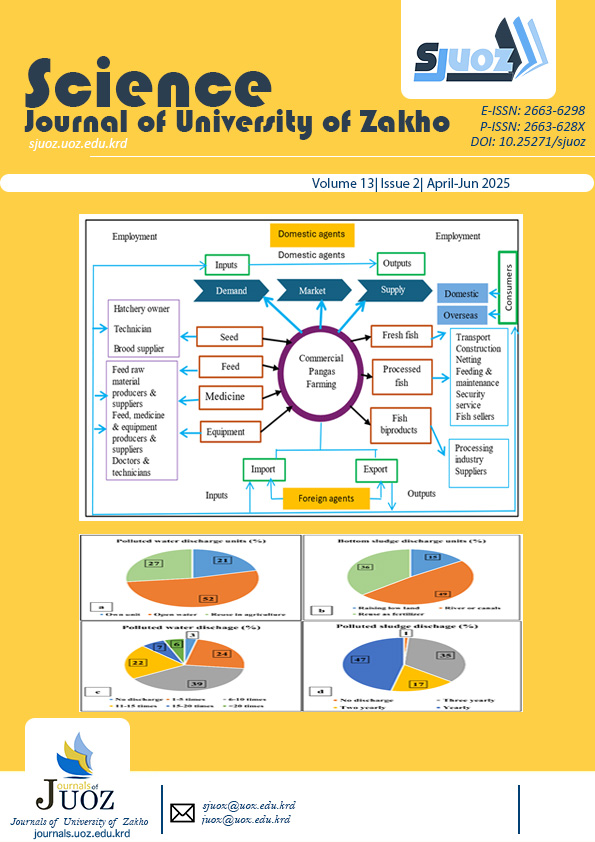KNEE OSTEOARTHRITIS STAGE CLASSIFICATION BASED ON HYBRID FUSION DEEP LEARNING FRAMEWORK
DOI:
https://doi.org/10.25271/sjuoz.2025.13.2.1450Keywords:
Deep learning, Deep learning fusion, Disease classification, Feature-level fusion, Knee osteoarthritisAbstract
Knee osteoarthritis severity detection is one of the most challenging applications in computer vision due to the similarity between X-ray images of the adjacent stages. Handling huge number of X-ray images and the ability to detect the correct disease stage is based on advanced artificial intelligence technologies, like machine learning and deep learning. This study presents a novel deep learning-based fusion framework designed for detecting the severity of knee osteoarthritis and classifying its stages. The study utilizes two X-ray image datasets containing three challenges: imbalanced data, low contrast, and low data size. Data augmentation, adaptive histogram equalization, and limited oversampling techniques were used to solve these problems. Five deep learning architectures were utilized as base models (EfficientNetB0, EfficientNetV2B0, XceptionNet, ResNetRS101, and RegNetY032), followed by average pooling and dense layers. The feature-level, decision-level, score-level, and meta-based fusion technologies were also performed on the outputs of the best three trained models to minimize the individual models’ errors. The study registered 70% and 90.61% classification accuracies using both datasets. The study also found that the best models are the score-level and meta-based fusion models in all scenarios.
Downloads
References
Ahmed, R., & Imran, A. S. (2024). Knee Osteoarthritis Analysis Using Deep Learning and XAI on X-rays. IEEE Access. https://doi.org/10.1109/ACCESS.2024.3400987
Ahmed, S. M., & Mstafa, R. J. (2022). Identifying Severity Grading of Knee Osteoarthritis from X-ray Images Using an Efficient Mixture of Deep Learning and Machine Learning Models. Diagnostics, 12(12), 2939. https://doi.org/10.3390/diagnostics12122939
Apon, T. S., Fahim-Ul-Islam, M., Rafin, N. I., Akter, J., & Alam, M. G. R. (2024). Transforming precision: A comparative analysis of vision transformers, CNNs, and traditional ML for knee osteoarthritis severity diagnosis. In 2024 6th International Conference on Electrical Engineering and Information & Communication Technology (ICEEICT) (pp. 31–36). IEEE. https://doi.org/10.1109/ICEEICT62016.2024.10534528
Bhateja, V., Dubey, Y., Maurya, N., Yadav, V. K., Shrivastava, S., Azar, A. T., Haider, Z., Amin, S. U., & Khan, Z. I. (2024). Ensemble CNN model for computer-aided knee osteoarthritis diagnosis. International Journal of Service Science, Management, Engineering, and Technology, 15(1), 1–17. https://doi.org/10.4018/IJSSMET.349913
Bose, A. S. C., Srinivasan, C., & Joy, S. I. (2024). Optimized feature selection for enhanced accuracy in knee osteoarthritis detection and severity classification with machine learning. Biomedical Signal Processing and Control, 97, 106670. https://doi.org/10.1016/j.bspc.2024.106670
Chawla, N. V., Bowyer, K. W., Hall, L. O., & Kegelmeyer, W. P. (2002). SMOTE: Synthetic Minority Over-sampling Technique. Journal of Artificial Intelligence Research, 16, 321–357. https://doi.org/10.1613/jair.953
Chen, P. (2018). Knee osteoarthritis severity grading dataset [Data set]. Mendeley Data. https://doi.org/10.17632/56rmx5bjcr.1
Chen, P., Gao, L., Shi, X., Allen, K., & Yang, L. (2019). Fully automatic knee osteoarthritis severity grading using deep neural networks with a novel ordinal loss. Computerized Medical Imaging and Graphics, 75, 84–92. https://doi.org/10.1016/j.compmedimag.2019.06.002
Chlap, P., Min, H., Vandenberg, N., Dowling, J., Holloway, L., & Haworth, A. (2021). A review of medical image data augmentation techniques for deep learning applications. Journal of Medical Imaging and Radiation Oncology, 65(5), 545–563. https://doi.org/10.1111/1754-9485.13261
Chollet, F. (2017). Xception: Deep Learning with Depthwise Separable Convolutions. In 2017 IEEE Conference on Computer Vision and Pattern Recognition (CVPR) (pp.1800-1807). IEEE https://doi.org/10.1109/CVPR.2017.195.
Du, Y., Shan, J., Almajalid, R., & Zhang, M. (2018). Knee osteoarthritis severity level classification using whole knee cartilage damage index and ANN. In Proceedings of the 2018 IEEE/ACM International Conference on Connected Health: Applications, Systems and Engineering Technologies (pp.19-21). ACM https://doi.org/10.1145/3278576.3278585
El Gannour, O., Hamida, S., Lamalem, Y., Mahjoubi, M. A., Cherradi, B., & Raihani, A. (2024). Improving skin diseases prediction through data balancing via classes weighting and transfer learning. Bulletin of Electrical Engineering and Informatics, 13(1), 628–637. https://doi.org/10.11591/eei.v13i1.5999
El-Ghany, S. A., Elmogy, M., & El-Aziz, A. A. A. (2023). A fully automatic fine tuned deep learning model for knee osteoarthritis detection and progression analysis. Egyptian Informatics Journal, 24(2), 229–240. https://doi.org/10.1016/j.eij.2023.03.005
Giannopapas, V., Smyrni, V., Kitsos, D. K., Stasi, S., Chasiotis, A. K., Moschovos, C., Papagiannopoulou, G., Stavrogianni, K., Kosmidou, M., Bakalidou, D., Tzartos, J. S., Tsivgoulis, G., & Giannopoulos, S. (2024). Osteoarthritis in people with multiple sclerosis: A systematic review and meta-analysis. Journal of Clinical Medicine, 13(17), 5015. https://doi.org/10.3390/jcm13175015
Han, X., Cui, J., Xie, K., Jiang, X., He, Z., Du, J., Chu, L., Qu, X., Ai, S., Sun, Q., Wang, L., Wu, H., Zhang, W., Yu, Z., & Yan, M. (2020). Association between knee alignment, osteoarthritis disease severity, and subchondral trabecular bone microarchitecture in patients with knee osteoarthritis: A cross-sectional study. Arthritis Research & Therapy, 22(1), 203. https://doi.org/10.1186/s13075-020-02274-0
Hoang, Q. T., Pham, X. H., Trinh, X. T., Le, A. V., Bui, M. V., & Bui, T. T. (2024). An efficient CNN-based method for intracranial hemorrhage segmentation from computerized tomography imaging. Journal of Imaging, 10(4), 77. https://doi.org/10.3390/jimaging10040077
Hu, C., Li, H., Ma, T., Zeng, C., & Ji, X. (2024). An improved image enhancement algorithm: Radial contrast-limited adaptive histogram equalization. Multimedia Tools and Applications, 83(36), 83695–83707. https://doi.org/10.1007/s11042-024-18922-5
Ilmi, B., Parellangi, P., Rizani, A., Hammad, H., Mallongi, A., & Palutturi, S. (2023). The effect of elderly hadrah gymnastics on muscle strength and scope of motion of lower extremity joints in elderly with osteoarthritis (Martapura River Region, South Kalimantan). Pharmacognosy Journal, 15(6), 1126–1131. https://doi.org/10.5530/pj.2023.15.205
Jahan, M., Hasan, Md. Z., Jahan Samia, I., Fatema, K., Rony, Md. A. H., Shamsul Arefin, M., & Moustafa, A. (2024). KOA-CCTNet: An enhanced knee osteoarthritis grade assessment framework using modified compact convolutional transformer model. IEEE Access, 12, 107719–107741. https://doi.org/10.1109/ACCESS.2024.3435572
Jain, R. K., Sharma, P. K., Gaj, S., Sur, A., & Ghosh, P. (2024). Knee osteoarthritis severity prediction using an attentive multi-scale deep convolutional neural network. Multimedia Tools and Applications, 83(3), 6925-6942. https://doi.org/10.1007/s11042-023-15484-w
Khozama, S., & Mayya, A. M. (2022). A new range-based breast cancer prediction model msing the bayes’ theorem and ensemble learning. Information Technology and Control, 51(4), 757–770. https://doi.org/10.5755/j01.itc.51.4.31347
Komalasari, D. R., & Motik, A. F. (2024). Reliability test of the Timed Up and Go test in elderly people with knee osteoarthritis. FISIO MU: Physiotherapy Evidences, 5(2), 129–140. https://doi.org/10.23917/fisiomu.v5i2.4227
Lu, J., Behbood, V., Hao, P., Zuo, H., Xue, S., & Zhang, G. (2015). Transfer learning using computational intelligence: A survey. Knowledge-Based Systems, 80, 14–23. https://doi.org/10.1016/j.knosys.2015.01.010
Goswami, M. K., & Das, A. (2023). Automatic classification of the severity of knee osteoarthritis using enhanced image sharpening and CNN. Applied Sciences, 13(3), 1658. https://doi.org/10.3390/app13031658
Messaoudene, K., & Harrar, K. (2024). Computerized diagnosis of knee osteoarthritis from x‐ray images using combined texture features: Data from the osteoarthritis initiative. International Journal of Imaging Systems and Technology, 34(2). https://doi.org/10.1002/ima.23063
Mohammed, A. S., Hasanaath, A. A., Latif, G., & Bashar, A. (2023). Knee osteoarthritis detection and severity classification using residual neural networks on preprocessed X-ray images. Diagnostics, 13(8), 1380. https://doi.org/10.3390/diagnostics13081380
Nasser, Y., El Hassouni, M., Hans, D., & Jennane, R. (2023). A discriminative shape-texture convolutional neural network for early diagnosis of knee osteoarthritis from X-ray images. Physical and Engineering Sciences in Medicine, 46(2), 827–837. https://doi.org/10.1007/s13246-023-01256-1
Niu, S., Liu, Y., Wang, J., & Song, H. (2020). A decade survey of transfer learning (2010–2020). IEEE Transactions on Artificial Intelligence, 1(2), 151–166. https://doi.org/10.1109/TAI.2021.3054609
Nouman, H. (2024). Annotated dataset for knee arthritis detection [Data set]. Kaggle. https://www.kaggle.com/datasets/hafiznouman786/annotated-dataset-for-knee-arthritis-detection
Nurmirinta, T. A., Turunen, M. J., Korhonen, R. K., Tohka, J., Liukkonen, M. K., & Mononen, M. E. (2024). Two-stage classification of future knee osteoarthritis severity after 8 years using MRI: data from the osteoarthritis initiative. Annals of Biomedical Engineering, 52(12), 3172-3183. https://doi.org/10.1007/s10439-024-03578-x
Pires, D. P. D. C., Monte, F. A. Do, Monteiro, L. F., Soares, F. R. D. C., & Faria, J. L. R. De. (2024). Updates in the treatment of knee osteoarthritis. Revista Brasileira de Ortopedia, 59(3), 337–348. https://doi.org/10.1055/s-0044-1786351
Pradipta, G. A., Wardoyo, R., Musdholifah, A., Sanjaya, I. N. H., & Ismail, M. (2021). Smote for handling imbalanced data problem: A review. 2021 Sixth International Conference on Informatics and Computing (ICIC), 1–8. https://doi.org/10.1109/ICIC54025.2021.9632912
Radosavovic, I., Kosaraju, R. P., Girshick, R., He, K., & Dollár, P. (n.d.). Designing network design spaces. arXiv. https://arxiv.org/abs/2003.13678
Rani, S., Memoria, M., Almogren, A., Bharany, S., Joshi, K., Altameem, A., ... & Hamam, H. (2024). Deep learning to combat knee osteoarthritis and severity assessment by using CNN-based classification. BMC Musculoskeletal Disorders, 25(1), 817. https://doi.org/10.1186/s12891-024-07942-9
Raza, A., Phan, T. L., Li, H. C., Hieu, N. V., Nghia, T. T., & Ching, C. T. S. (2024). A comparative study of machine learning classifiers for enhancing knee osteoarthritis diagnosis. Information, 15(4), 183. https://doi.org/10.3390/info15040183.
Rehman, S. U., & Gruhn, V. (2024). A sequential VGG16+CNN-based automated approach with adaptive input for efficient detection of knee osteoarthritis stages. IEEE Access, 12, 62407–62415. https://doi.org/10.1109/ACCESS.2024.3395062
Rifat, R. H. (2024). A semi-supervised federated learning approach leveraging pseudo-labeling for knee osteoarthritis severity detection. http://hdl.handle.net/10361/24036
Shorten, C., & Khoshgoftaar, T. M. (2019). A survey on image data augmentation for deep learning. Journal of Big Data, 6(1). https://doi.org/10.1186/s40537-019-0197-0
Szabó, S., Holb, I. J., Abriha-Molnár, V. É., Szatmári, G., Singh, S. K., & Abriha, D. (2024). Classification assessment tool: A program to measure the uncertainty of classification models in terms of class-level metrics. Applied Soft Computing, 155, 111468. https://doi.org/10.1016/j.asoc.2024.111468
Tan, M., & Le, Q. (2019). EfficientNet: Rethinking model scaling for convolutional neural networks. In Proceedings of the International Conference on Machine Learning (pp. 6105-6114). https://doi.org/10.48550/arXiv.1905.11946
Tan, M., & Le, Q. (2021). EfficientNetV2: Smaller models and faster training. Proceedings of the 38th International Conference on Machine Learning (ICML 2021), PMLR 139, 10096–10106. https://proceedings.mlr.press/v139/tan21a.html
Watso, J. C., & Vondrasek, J. D. (2024). Risks of exercise in older adults. In Exercise for aging adults (pp. 29–45). Springer International Publishing. https://doi.org/10.1007/978-3-031-52928-3_3
Wightman, R., Touvron, H., & Jégou, H. (2021). ResNet strikes back: An improved training procedure in timm. arXiv. https://arxiv.org/abs/2103.00388
Yildirim, M., & Mutlu, H. B. (2024). Automatic detection of knee osteoarthritis grading using artificial intelligence–based methods. International Journal of Imaging Systems and Technology, 34(2), e23057. https://doi.org/10.1002/ima.23057
Zhao, H., Ou, L., Zhang, Z., Zhang, L., Liu, K., & Kuang, J. (2025). The value of deep learning-based X-ray techniques in detecting and classifying KL grades of knee osteoarthritis: a systematic review and meta-analysis. European Radiology, 35(1), 327-340. https://doi.org/10.1007/s00330-024-10928-9
Zhu, S., Qu, W., & He, C. (2024). Evaluation and management of knee osteoarthritis. Journal of Evidence-Based Medicine, 17(3), 675–687. https://doi.org/10.1111/jebm.12345
Published
How to Cite
Issue
Section
License
Copyright (c) 2025 Delveen Luqman Abd Alnabi, Shereen sh. Ahmed, Nisreen Luqman Abd Alnabi

This work is licensed under a Creative Commons Attribution 4.0 International License.
Authors who publish with this journal agree to the following terms:
- Authors retain copyright and grant the journal right of first publication with the work simultaneously licensed under a Creative Commons Attribution License [CC BY-NC-SA 4.0] that allows others to share the work with an acknowledgment of the work's authorship and initial publication in this journal.
- Authors are able to enter into separate, additional contractual arrangements for the non-exclusive distribution of the journal's published version of the work, with an acknowledgment of its initial publication in this journal.
- Authors are permitted and encouraged to post their work online.








